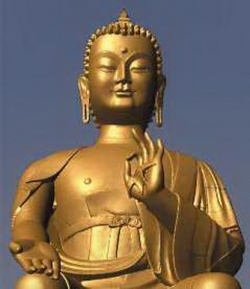Maitreya claimants
Since his death, the Chinese monk Hotei has been popularly regarded as an incarnation of the bodhisattva Maitreya. His depiction as the Laughing Buddha Laughing Buddha continues to be very popular in East Asian culture. While a number of persons have proclaimed themselves to be Maitreya over the years following the Sakyamuni Buddha’s death, none have been officially recognized by the sangha and the Buddhist people. A particular difficulty faced by any would-be claimant to Maitreya's title is the fact that the Buddha is considered to have made a number of fairly specific predictions regarding the circumstances that would occur prior to Maitreya's coming- such as that the teachings of the Buddha would be completely forgotten, and all of the remaining relics of Sakyamuni Buddha would be gathered in Bodh Gaya and cremated. An example of a self-proclaimed incarnation of Maitreya is found in the I-Kuan Tao religious movement, which believes that Lu Zhong Yi, the 17th patriarch of I-Kuan Tao, proclaimed himself to be an incarnation of Maitreya. L. Ron Hubbard, founder of Scientology, has also claimed that he was the fulfillment of Maitreya prophecy in a poem called "Hymn of Asia," penned somewhen between 1955 and 1956. What follows is one of its declarations: :Everywhere you are I can be addressed, But in your temples best, Address me and you address, Lord Buddha, Address Lord Buddha, then you address Maitreya. (American Graphics Inc., 1974) It has been suggested by some that Ram Bahadur Bomjon, a teenage monk in Nepal who began a long period of meditation on May 16, 2005, could be an incarnation of Maitreya. He himself has denied that he is a Buddha. After ten months of sitting in meditation without eating or drinking, he disappeared and is sought after by the Nepalee police.
